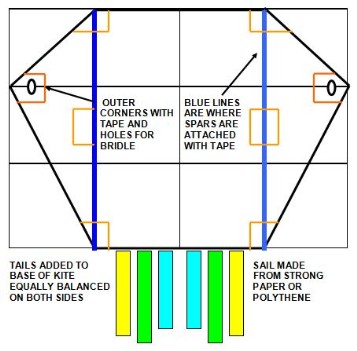DESIGN TECHNOLOGY IN THE PRIMARY SCHOOL
Main menu:
WIND ENERGY AND FLIGHT
MATHS AND SCIENCE LINKS
WIND ENERGY AND FLIGHT
DESIGN AND MAKE PROBLEM SOLVING SITUATIONS
DISPERSAL OF SEEDS, DESIGN A SHAPE THAT SPINS WHILE IT FALLS
Certain trees such as Sycamore, Elm, Ash and Lime, and plants such as Dandelion and Goatsbeard have seeds that spin through the air and are blown to other parts of the field and forest. Make a study of the way these and other seeds fall to the ground.
Materials:- thin paper, polystyrene lids or sheet, plastic drinking straws, dowel, small weight. Write down and discuss some of the things you discovered while making the spinner.
How can you test it safely?
DESIGN AND MAKE A MODEL PARACHUTE
On a recent visit to an airport we saw a parachutist land on the airfield. How do you think parachutes work? Make a study of things that float in the air. Try and make a parachute to carry a star wars figure, action man or "Barbie doll" or plastic building brick and see how well it works.
Materials:- Polythene or paper carrier bag, large serviettes, string, and small load. Write down some of the things you discovered or had to do while making the parachute. How can you test it? Make it clear how you made each stage so that a friend can make one.
DESIGN AND MAKE A HAND HELD WINDMILL
While on a visit to the seaside a friend bought a small windmill on a stick that spins around in the wind. Find out about other types of windmill and what they are used for. Find out how they move and spin in the wind. What are the spinning parts called?
Materials:- pieces of thin card/plastic 20 cms. square, dowel or cane, thin wire, beads or sequins. If the first model works make a larger one to put on the school flagpole, or a post in the garden. Can you tell how fast it spins.
WIND DIRECTION INDICATOR
DESIGN AND MAKE A WEATHER VANE TO SHOW WIND DIRECTION
On a local church steeple there is a weather vane which moves to face the direction of the wind. Find out about the points of the compass and other things that could be used to tell the direction of the wind. How do they work? How do they revolve? Use an animal shape for the outline of the weather vane.
Materials:- thin card 30 cms. square, dowel or cane, cotton reels, corks or beads, and a suitable base to fasten it to. How can we test it? Which direction did it face?
WIND SPEED INDICATOR
DESIGN AND MAKE A DEVICE THAT WILL SHOW WIND SPEED
At an airfield we have seen what looks like a large sock which blows around in the wind to tell the pilots which direction the wind is blowing from and how fast it is blowing. What other things could be used to show the speed of the wind? How could they move around to face the wind? (Anemometers)
Materials:- suitable paper, polythene or fabric, thin card, dowel or cane, plastic cups, cotton reels, corks or beads. Write down some of the things you discovered or had to do while making the wind speed indicator. How can you test it to show different speeds?
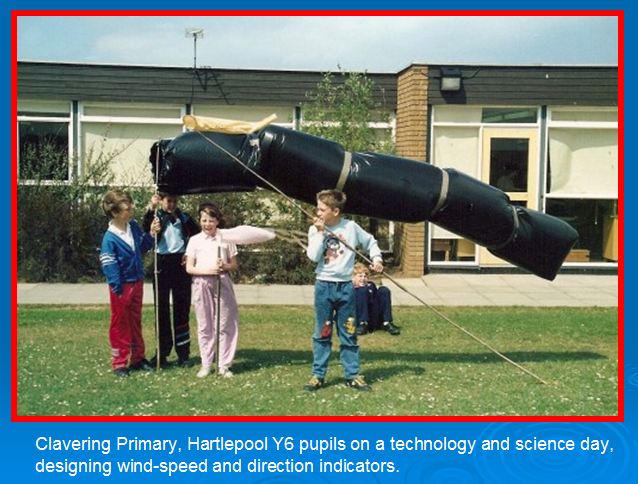
DESIGN A BOOMERANG SPINNER THAT SPINS THROUGH THE AIR AND RETURNS
In Australia the Aborigines use a boomerang which spins through the air and returns to a spot near the person who has thrown it. It could have several more arms. Name several things which can be thrown in sports activities.
Materials:- thin card 20cms square, if the first model works well make a larger one in thicker card. Write down or discuss some of the things you discovered while making the spinner.
How can you launch it safely?
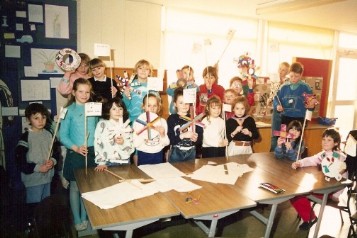
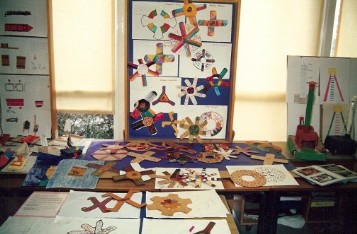
DESIGN AND MAKE A PAPER AEROPLANE
Sweeping and soaring, silently gliding through the air on a flight-path to where? What other words could be used to describe how the paper airoplane flies? How do we fold it to make sure it is balanced on both wings? Books are available with simple instructions for folding various paper aeroplanes.
Materials:- One piece of A4 paper Decorate the wings and body of the plane with coloured designs. How can you launch it? How far and how straight did it fly?
DESIGN AND MAKE A MOBILE
Above a baby's cot is a mobile that spins round in the air currents. How are the pieces balanced? How can we fasten it to the ceiling, or cot? Your task is to design and make a brightly coloured mobile that will move around in the air currents of the room. Use no more than six small animals, fish, bird, or other simple shapes for objects that will hang from the mobile.
Materials to be used:- pieces of dowel or cane, card, thread or string, and various decorative papers. Draw out your designs for the shapes that will hang from the mobile and use brightly coloured materials to decorate them.
DESIGN AND MAKE A MODEL HOT AIR BALLOON
Many people have travelled around the world using large balloons with a basket underneath in which they sit. Recently Richard Branson tried to cross the Atlantic in a very large balloon specially made for long distance travel. How do these balloons rise in the air? It would be very difficult to make a working model that would work in the classroom. Any ideas why?
Your task is to design and make a decorative hot air balloon that could hang from the ceiling. Your model should be bright and colourfully decorated in some way.
Materials to be used:- An inflated balloon, newspaper, tissue and glue, thread and string, suitable container for the basket. This is basically "papier mache" using strips of newspaper. Inflate a pear shaped balloon, nozzle tied tightly and stand in a weighted container. Paste the strips on the crown, and then cover the whole surface with three layers. Allow to dry and then decorate. Finally add the basket.
DESIGN AND MAKE A KITE
Sweeping and soaring, ducking and diving, tossing and turning, pulling at your hand and flying like a bird. What other words could be used to describe how a kite flies? How does it work? What is the best shape for a kite? What are the names of the parts of the kite? Sail, spars, tails, bridle and line.
Materials:- suitable paper, polythene or fabric, thin dowel or cane, parcel tape, string for the bridle. (A decorative carrier bag or bin liner can be used) Decorate the sail of the kite with a design or symbol. Write a story of what it might feel like flying in the air, looking down on the fields, houses and landscape.
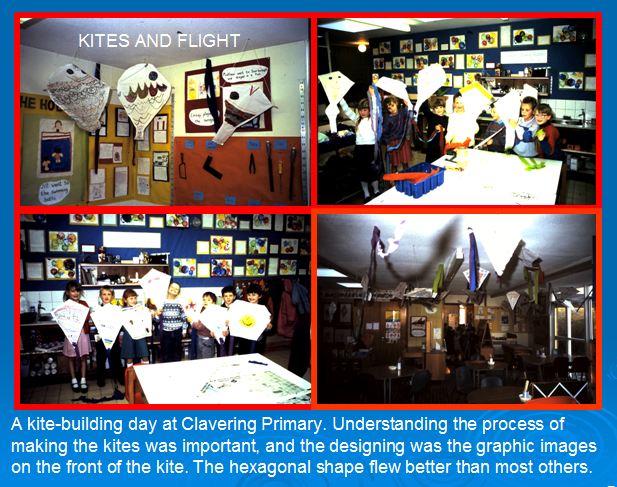
Every child should have the experience of designing, making and flying a kite, even if the teacher treats it as a practically focused task, simply guiding them through the process. Some kites involve a diamond or an irregular hexagonal sled shape, which is basically symmetrical, with pupils involved in measuring and mathematical issues as well as basic scientific principles of flight. But the end product of actually flying the kites on a short line in the playground gives a unique excitement and experience that will be everlasting, and hold their interest for the rest of the year.
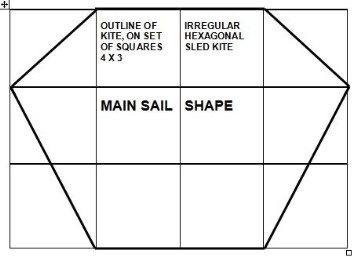
PRACTICALLY FOCUSSED TASK - PROCESS AND TECHNIQUES
FOR MAKING A SLED KITE
- Draw out a grid of squares 4 X 3 on A3 paper or polythene.
- A plastic carrier bag could be used for the sail.
- The grid for the sail can be enlarged or reduced.
- Then draw the outline of the kite sail as an irregular hexagon.
- Cut out the main outline shape.
- Add two spars as shown in diagram and tape them to the sail with parcel tape.
- Reinforce the outer two corners with tape and punch holes to take the bridle.
- The Bridle is 3 to 4 times width of the sail and fastened loosely into each hole.
- A small loop is made in the middle of the bridle to attach the main line of the kite. This can be as short as 6 metres or much longer.
- Add tails to the bottom edge of the kite sail, each one at least 3 times the height of the kite.
- They must be balanced along this bottom edge, two on each side, 3 on each side or right across the edge.
- Now go and fly your kite.
- Every one a success. Happy Flying!
